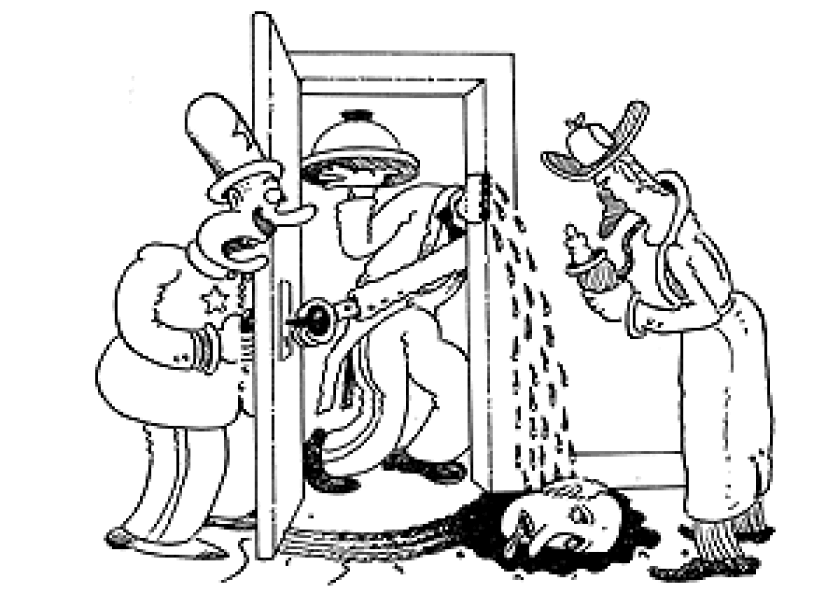Dear Cecil: Oft have we all heard the aged whodunit cliche “The butler did it!” But when did the butler ever do it? I’ve never heard of the butler actually having done it. How did this cliche become the cliche it became if there were never any butlers who did it? Brian J. Wright, via e-mail
Cecil replies:
Of course butlers do it. How do you think they make little butlers? What you really want to know is whether the butler in a whodunit ever actually committed the murder (detective-story rule number seven says it must always be a murder), and what writer was initially responsible for this cliche most foul. Which, with apologies to Agatha Christie, is the last detective-story cliche you’ll read in this column. Little Ed and I initially connived to cram it full of Conan Doyle-isms, but halfway through I looked at him and said, “Are you thinking what I’m thinking?”
“Yes,” he admitted. “The plot sickens.”
The expression “the butler did it” is commonly attributed to novelist Mary Roberts Rinehart (1876-1958), who wrote dozens of popular books, starting with The Circular Staircase in 1908. In 1930 she published The Door, in which — I’m sorry if this ruins the suspense for you — the butler does it. But the words “the butler did it” do not appear in the book, as far as I can tell — I confess I skimmed — and Rinehart was hardly the first crime writer to implicate a menial. Denying her this distinction (if such it be) isn’t going to dim her legacy, however. Among connoisseurs of the detective story Rinehart is famous (or perhaps notorious) as the originator of the had-she-but-known school of crime fiction, in which the story is narrated by a once-naive-but-now-older-and-wiser woman. Formulaic though it was, this approach helped her sell roughly ten million books during her lifetime. In 1929 she helped two of her sons found the publishing house of Farrar and Rinehart, which printed her books from then on — to my mind the surest means yet devised to guarantee a successful career as a writer. (Farrar and Rinehart is no more, but the family name survives at Holt, Rinehart and Winston.)
Back to our story. As I say, Rinehart was not the first to turn suspicion on the servant class in her detective fiction. One of the earliest was the writer who largely created the genre, Arthur Conan Doyle. In “The Musgrave Ritual,” from The Memoirs of Sherlock Holmes (1893), the butler Brunton, though not the central bad guy, is found dead beside the chest that had contained the Musgrave family treasure — “the butler, guilty of betrayal and theft, paid with his life for his perfidy,” as the Oxford Companion to Crime & Mystery Writing puts it. And in Agatha Christie’s The Murder of Roger Ackroyd (1926), suspicion initially falls on Ackroyd’s butler Parker, owing to his criminal past.
Still, crime-fiction writers of the day tended to think that casting one of the hired help as the culprit was cheating. (That is, it was only OK for the butler to be suspected of doing it.) In his 1928 essay “Twenty Rules for Writing Detective Stories” (the source of rule number seven above — you thought I was making this up?), S.S. Van Dine spells this out in rule eleven: “A servant must not be chosen by the author as the culprit. This is begging a noble question. It is a too easy solution. The culprit must be a decidedly worth-while person — one that wouldn’t ordinarily come under suspicion.” Noting the blithe classism in this suggestion, we return to the Oxford Companion: “Because the butler can move about the house in the course of his duties with complete freedom and because he is so taken for granted by the other characters that no one pays attention to him, he makes an ideal culprit.”
You see the divide here. Too easy! say fans of the ten-people-in-a-country-house subgenre. Perfect! say slightly more adventurous writers, and indeed, having the butler do it seems like a great opportunity to inject the resentments of the proletariat into the genteel world of Hercule Poirot and his ilk. But few writers took the bait: I can find only one detective story prior to Rinehart’s in which a butler commits the pivotal crime, “The Strange Case of Mr. Challoner” by Herbert Jenkins (1921). Once the device had been fixed in the popular mind by Rinehart’s book, it became an easy target for satirists (and thus off-limits to most everybody else); see for example Damon Runyon’s 1933 story “What, No Butler?” and P.G. Wodehouse’s 1957 novel The Butler Did It.
But give Rinehart her due. Though she may never have written those fateful words, she could honestly say that she made them a cliche.
Cecil Adams
Send questions to Cecil via cecil@straightdope.com.
